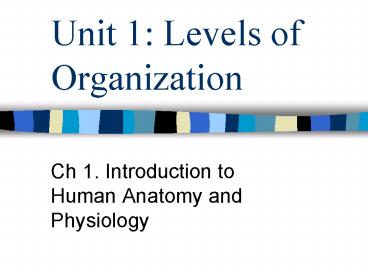Unit 1: Levels of Organization PowerPoint PPT Presentation
1 / 25
Title: Unit 1: Levels of Organization
1
Unit 1 Levels of Organization
- Ch 1. Introduction to Human Anatomy and Physiology
2
What is Anatomy and Physiology?
- Anatomy the branch of science that deals with
the structure of body parts their forms and how
they are organized - Physiology the branch of science that deals
with the functions of the body parts, what they
do and how they do it.
3
- It is difficult to separate the topics of anatomy
and physiology because the structures of the
body are closely associated with their functions. - Ex. The hollow chambers of the heart are adapted
to pump blood through tubular blood vessels
4
Characteristics of Life
- Growth organisms change throughout their life
span - Reproduction making more of ones self
- Respiration releasing energy from food
- Digestion and Absorption breaking down food
into a usable form and passage of substances
through membranes - Excretion removal of wastes produced
- Response to Stimulus change in position of body
or of a body part motion of an internal organ - Adaptation reaction to environment
5
Requirements of Living Organisms
- Water
- Food
- Oxygen
- Heat
- Pressure
6
Water
- most abundant chemical in the body,
- required for most metabolic processes,
- transports substances within the organism,
- important in regulating body temperature
7
Food
- substances that provide the body with necessary
chemicals (nutrients) - used as energy sources
- supply raw materials for building new living
matter - help regulate vital chemical reactions
8
Oxygen
- gas that makes up about one-fifth of the air we
breathe - used to release energy from food
- helps drive metabolic processes
9
Heat
- Is a form of energy
- Product of metabolic reactions
- More heat faster reactions
10
Pressure
- Is an application of force to something
- Atmospheric pressure the force on the outside
of the body due to the weight of air above - Helps us breathe
- Hydrostatic pressure pressure a liquid exerts
due to the weight of water above them (important
for organisms living under water) - Heart action produces blood pressure which forces
blood through the body
11
Anything else?
- Although organisms require water, food, oxygen,
heat, and pressure, these factors alone are not
enough to ensure survival. - Both the quantity and quality of each factor are
important - Ex. Concentration of oxygen, nutrients in food,
purity of water
12
Homeostasis
- Organisms Internal Regulation
- Examples of physiological conditions requiring
homeostasis - Temperature
- Concentration of Waste Products
- Gas Exchange
- pH
- Energy Requirements
- Water/Ion balance
- Volume/Pressure
http//www.bioedonline.org/slides/
13
14
Components of Homeostasis
- Receptors provide information about conditions
(stimuli) in the internal environment - Set Point tells what a particular value should
be - Ex. Body temperature should be 98.6oF
- Effectors cause responses that alter conditions
in the internal environment
15
Internal Temperature Regulation
16
Homeostasis Cont.
- Homeostatic mechanisms monitor aspects of the
internal environment and correct any changes that
occur. - Such response is called a negative feedback
mechanism - The deviation from the set-point is corrected
- Correction reduces the action of the effectors
- Keeps the correction from going too far
17
(No Transcript)
18
Homeostasis Cont.
- Homeostatic mechanisms maintain a relatively
constant internal environment, yet physiological
values may vary slightly from one individual to
the next - Both normal values for an individual and the
normal range for the general population are
clinically important
19
Levels of Organization
- http//fulton.edzone.net/winkler/team3/chapter01/L
evels20of20Organization.jpeg
20
Levels of Organization Cont.
- Body parts can be thought of as having different
levels of organization, such as the atomic level,
molecular level, or cellular level. - Body parts vary in complexity from one level to
the next - Atoms are less complex than molecules, molecules
are less complex than organelles, tissues are
less complex than organs, and so forth.
21
Organization of the Human Body
- Axial portion head, neck, and trunk
- Dorsal cavity
- Cranial cavity skull and brain
- Vertebral canal spinal cord within sections of
the backbone - Ventral cavity visceral organs/viscera (organs
contained within the ventral cavity) - Thoracic cavity (thoracic and abdominopelvic
cavities are separated by the diaphragm) - Abdominopelvic cavity
- Abdominal cavity stomach, liver, spelln,
gallbladder, kidneys, intestines - Pelvic cavity large intestine, urinary bladder,
reproductive organs - Appendicular portion upper and lower limbs
22
clem.mscd.edu/biology/ 231course/cavity.jpg
23
Organ Systems
- The human organism consists of several organ
systems. Each system includes a set of
interrelated organs that work together to provide
specialized functions - Body Covering
- Integumentary System
- Support and Movement
- Skeletal System
- Muscular System
- Integration and Coordination
- Nervous System
- Endocrine System
- Transport
- Cardiovascular System
- Lymphatic System
- Absorption and Excretion
- Digestive System
- Respiratory System
- Urinary System
- Reproduction
- Reproductive System (male and female)
24
Anatomical Terminology
- To communicate effectively, researchers and
clinicians have developed a set of terms to
describe anatomy - When we use the terms, we assume that the body is
in the anatomical position, which means - standing erect
- face forward
- upper limbs at the sides and palms forward
- Right and left refers to the right and left of
the body in anatomical position
25
Anatomical Position
www.emergencymedicaled.com/ images/Anatomical

